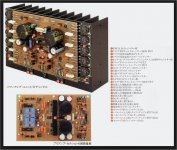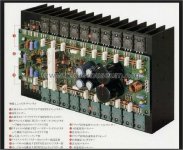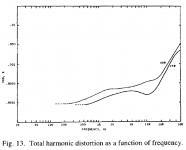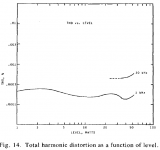Accuphase ...
REAL good designs.
I was inspired by them as much as H/K.
E and P series (below) , similar to my slewmasters with fast
Sanken or toshiba EF3's driven by a CFA.
The new M series .... Accuphase Laboratory, Inc.?M-6200
is "scary power" ....
PS - I've auditioned the E series , as well as the H/K990 (VFA).
BOTH are impressive amplifiers despite being VFA-CFA.
OS
REAL good designs.
I was inspired by them as much as H/K.
E and P series (below) , similar to my slewmasters with fast
Sanken or toshiba EF3's driven by a CFA.
The new M series .... Accuphase Laboratory, Inc.?M-6200
is "scary power" ....
PS - I've auditioned the E series , as well as the H/K990 (VFA).
BOTH are impressive amplifiers despite being VFA-CFA.
OS
Attachments
Hi. I have not heard nor tested his preamp. I would like to know also.
Something missing about slew rate..... IMO this has nothing much to do with the signal rise time etc from the source. It is why does a higher SR of the amplifier makes the amplifier more accurate. (even with input BW limited). It seems to need faster speed by a fair margin than the signal BW or Tr would indicate to sound best. It is something within the amp itself perhaps. Speed of correction? Or is it all the things a CFA brings - the combination -- which makes it better? Reduction of affect of non-linear C's in the devices?
SR is a marker or indicator.... the end result must relate to error correction or distortion reduction somehow.
A lot of audio companies (Japanese etal) noticed before us that CFA sounds better. Most of the High End models from various manufacturers get changed to CFA just for their top model.,,, and some do not mention it in their literature/marketing but need to remain competitive.
THx-RNMarsh
Last edited:
JC
A bit confused. Slew rate = 1.414 x w x sqrt( W x R ).
w = omega or 2 x pi x frequency of interest. W = Watts R = load resistance.
So even 10 watts at 20,000 Hz into 8 ohms requires more the 1V/uS.
ES.
Slew rate in a feedback system is meaningless if the the system is in full slew. I remember the spec was based on something like 3% THD for a sine wave at full output (or the needed output). to be useful. For example if you are moving a disk head to a specific track and the system is in saturation recovering from saturation will seriously slow down the settling time of the disk head. Same for the output of an amplifier. Most audio slew rates are quoted in full saturation and really only meaningful when boasting.
Settling time to a specific accuracy will encompass a number of aspects that are important, but can be really hard to explain to customers looking for the biggest number.
30 years ago there was a battle over slew rate in high end audio. I built a VFA amp with 1000V/uS slew rate and made the mistake of putting a slew rate meter on the front. Nothing could get it to budge in program material (and this was in the vinyl only days).
I think slew rate is an indicator of good design but not the end goal.
Most audio slew rates are quoted in full saturation and really only meaningful when boasting.

Slew rate in a feedback system is meaningless if the the system is in full slew. . Most audio slew rates are quoted in full saturation and really only meaningful when boasting.
Settling time to a specific accuracy will encompass a number of aspects that are important, but can be really hard to explain to customers looking for the biggest number.
30 years ago there was a battle over slew rate in high end audio. I built a VFA amp with 1000V/uS slew rate and made the mistake of putting a slew rate meter on the front. Nothing could get it to budge in program material (and this was in the vinyl only days).
I think slew rate is an indicator of good design but not the end goal.
Hi Demian,
I think most of us know what SR limiting is in an amplifier and how it relates to distortion via IPS I and C. Thinking outside the box... The real question still remains that CFA sounds better and SR is a characteristic of CFA's basic 'skill set' ... maybe indirectly... helps sound better. Thus a marker for CFA circuits.
The other characteristics outlined thoroughly else where cause the SR to be high and does so while making it more linear over a wide dynamic range. This is more directly at the root of the better sound.
I am not over-looking the fact that these circuits recently developed here by our friends at DIYAudio are also linear to a level we havent seen ..... including the OPS and at any freq and at any power short of clipping. This also contributes. Had we had such VFA before, maybe there would be no need for CFA to rise above. Dont know. But, it has been shown that both are very capable of a lot more than we have had commercially to purchase or to listen to. You really need to test and hear them. But so far the topology and CFA operating mode has the edge ahead and for me that is enough.
THx-RNMarsh
Last edited:
Attachments
Last edited:
This may qualify. >300v/us SR. current-mirrors... uses and needs complex error-corrected OPS... DIY dont need the error-correction circuitry to cancel distortion. Compensation a bit tricky. Never the less, all the good stuff except the dynamic current on demand. It also isolates the Vas well from Load. Important. V.Good VFA design. As are recent OS and others not using error-correction. I used to think error-correction was going to be the only way to get such low distortion..... but now we dont have to. I have never heard it under dynamic playing conditions.
THx-RNMarsh
THx-RNMarsh
Last edited:
What is the design solution with VFA that will cause this dynamically changing distortion to be a constant, unchanging and at very low level... virtually unchanging with freq and power and load.... a straight line across the bottom of the graph (dotted line)? Do it for 200W/8
THx-RNMarsh
Put a tube buffer in front of a very linear amp. All you will see is the distortion of the tube buffer. Any amp that has this distortion profile is essentially doing just that, just without being obvious.
Usually when you get an amp where the distortion is level with frequency, it's not because it doesn't generate frequency-dependent distortion, but rather that is swamped by a source constant distortion.
The same is true of a "monotonic" harmonic spectrum. Say that an amp has H2 at -70db and H7 at -90db. Then compare that with another amp that has H2 at -110db and H7 at -100db. Is the second amp worse because it's not monotonic, or better because H7 is lower? If monotonicity is more important, then would the first amp still beat the second amp if the second amp had a tube buffer in front of it?
I see people rejecting the second design all the time, without even realizing that the high order harmonics are in fact at a lower level. They assume without paying attention to the scale that the first amp is "smoother" even though it actually has more high order harmonics.
Last edited:
Smoke on the water, and fire in the skySo even 10 watts at 20,000 Hz into 8 ohms requires more the 1V/uS.
There isn't much content level in real programme material at such frequencies. Besides, one can't evaluate programme material slew rate from sinusoids, because it is a random composite of all frequencies and phases and various levels. It is best to measure it.
Mistracking is not normal, and that is not the point anyway. Even in normal programme material, there is no significant slew rate difference between vinyl and digital sources. This is because programme content is the limiting factor, ie natural sound does not contain slew rates fast enough to expose any difference in system capability.Slew rate in MC analog vinyl playback is MUCH more than digital mostly due to MISTRACKING, that happens all the time.
QED. Surprise is that if you now did it again with digital sources, you'd find the same thing !30 years ago there was a battle over slew rate in high end audio. I built a VFA amp with 1000V/uS slew rate and made the mistake of putting a slew rate meter on the front. Nothing could get it to budge in program material (and this was in the vinyl only days).
30 years ago there was a battle over slew rate in high end audio.
And this is not a case of l'histoire se répète, in your opinion, Mr Martin ?
Quite so, Jacco, the memories of the slew Rate Wars, waged mostly (but not exclusively) by Sansui, Kenwood an Pioneer. The problem even then was that that nobody actually explained why we need extreme slew rates, just some assumption that the bigger the slew rate, the better the sound. All very shady and clear as mud. AS a result of that, most people even toda have no idea what it really does, how to get it and how far to push it. In terms of clear explanations, we effectively wasted the time from say the late 70ies to today.
Quite so, Jacco, the memories of the slew Rate Wars, waged mostly (but not exclusively) by Sansui, Kenwood an Pioneer. The problem even then was that that nobody actually explained why we need extreme slew rates, just some assumption that the bigger the slew rate, the better the sound. All very shady and clear as mud. AS a result of that, most people even toda have no idea what it really does, how to get it and how far to push it. In terms of clear explanations, we effectively wasted the time from say the late 70ies to today.
I am so sorry for your wasted time.
I am so sorry for your wasted time.
What are you on about?
It is best to measure it.
Pretty easy to scan a .wav file and plot a histogram of sample to sample difference.
Slew rate in a feedback system is meaningless if the the system is in full slew. I remember the spec was based on something like 3% THD for a sine wave at full output (or the needed output). to be useful. For example if you are moving a disk head to a specific track and the system is in saturation recovering from saturation will seriously slow down the settling time of the disk head. Same for the output of an amplifier. Most audio slew rates are quoted in full saturation and really only meaningful when boasting.
Settling time to a specific accuracy will encompass a number of aspects that are important, but can be really hard to explain to customers looking for the biggest number.
30 years ago there was a battle over slew rate in high end audio. I built a VFA amp with 1000V/uS slew rate and made the mistake of putting a slew rate meter on the front. Nothing could get it to budge in program material (and this was in the vinyl only days).
I think slew rate is an indicator of good design but not the end goal.
Demian,
We aren't communicating!
We do look at different sized systems.
For a short (to me) 200' throw the atmospheric loss is around 18 db at 12,000 Hz. The path length loss is 34 db. Allowing for the energy content of music peaking at 150 Hz with a 3 db/octave roll off requires 20 dB less power.
So with a horn tweeter of 109 dB/W to produce a modest 110 dB peak level yields a power requirement of 110 - 109 + 18 + 34 - 20 = 33 dB re 1W or 2 kW!
That is why in my systems the tweeters typically require more power than the woofers.
The slew rate required is 13.5 V/uS. The amplifiers used often have a rating of 15 V/us. (Which also explains why few large systems go much above 10,000 hz.)
- Status
- Not open for further replies.
- Home
- Member Areas
- The Lounge
- John Curl's Blowtorch preamplifier part II



